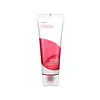What's inside
What's inside
 Key Ingredients
Key Ingredients

 Benefits
Benefits

 Concerns
Concerns

 Ingredients Side-by-side
Ingredients Side-by-side

Water
Skin ConditioningSodium Lauroyl Sarcosinate
CleansingAcrylates Copolymer
Cocamidopropyl Betaine
CleansingDisodium Cocoamphodiacetate
CleansingGlycerin
HumectantNiacinamide
SmoothingPhenoxyethanol
PreservativeEthylhexylglycerin
Skin ConditioningSodium Hydroxide
BufferingDextran
Tripeptide-1
Skin ConditioningPalmitoyl Tripeptide-5
Skin ConditioningSodium Benzoate
MaskingMethoxycinnamidopropyl Hydroxysultaine
UV AbsorberSalicylic Acid
MaskingBetaine
HumectantSodium Gluconate
Skin ConditioningCentella Asiatica Extract
CleansingAloe Barbadensis Leaf Extract
EmollientBiosaccharide Gum-4
Skin ConditioningHyaluronic Acid
HumectantWater, Sodium Lauroyl Sarcosinate, Acrylates Copolymer, Cocamidopropyl Betaine, Disodium Cocoamphodiacetate, Glycerin, Niacinamide, Phenoxyethanol, Ethylhexylglycerin, Sodium Hydroxide, Dextran, Tripeptide-1, Palmitoyl Tripeptide-5, Sodium Benzoate, Methoxycinnamidopropyl Hydroxysultaine, Salicylic Acid, Betaine, Sodium Gluconate, Centella Asiatica Extract, Aloe Barbadensis Leaf Extract, Biosaccharide Gum-4, Hyaluronic Acid
Cetyl Ethylhexanoate
EmollientIsopropyl Myristate
EmollientIsopropyl Palmitate
EmollientHydrogenated Polyisobutene
EmollientHelianthus Annuus Seed Oil
EmollientCaprylic/Capric Triglyceride
MaskingC12-15 Alkyl Benzoate
AntimicrobialWater
Skin ConditioningSucrose Palmitate
EmollientSucrose Stearate
EmollientMacadamia Ternifolia Seed Oil
EmollientPrunus Amygdalus Dulcis Oil
Skin ConditioningCitrus Junos Fruit Extract
Skin ConditioningSqualane
EmollientButylene Glycol
HumectantAllantoin
Skin ConditioningCapryloyl Salicylic Acid
ExfoliatingCentella Asiatica Extract
CleansingPortulaca Oleracea Extract
Skin ConditioningMadecassoside
AntioxidantAsiaticoside
AntioxidantAsiatic Acid
Skin ConditioningMadecassic Acid
Skin ConditioningTocopherol
Antioxidant1,2-Hexanediol
Skin ConditioningGlycerin
HumectantEthylhexylglycerin
Skin ConditioningCetyl Ethylhexanoate, Isopropyl Myristate, Isopropyl Palmitate, Hydrogenated Polyisobutene, Helianthus Annuus Seed Oil, Caprylic/Capric Triglyceride, C12-15 Alkyl Benzoate, Water, Sucrose Palmitate, Sucrose Stearate, Macadamia Ternifolia Seed Oil, Prunus Amygdalus Dulcis Oil, Citrus Junos Fruit Extract, Squalane, Butylene Glycol, Allantoin, Capryloyl Salicylic Acid, Centella Asiatica Extract, Portulaca Oleracea Extract, Madecassoside, Asiaticoside, Asiatic Acid, Madecassic Acid, Tocopherol, 1,2-Hexanediol, Glycerin, Ethylhexylglycerin
Ingredients Explained
These ingredients are found in both products.
Ingredients higher up in an ingredient list are typically present in a larger amount.
Centella Asiatica Extract (Centella) is derived from an herb native to Southeast Asia. It is famous for its anti-inflammatory and soothing properties.
Centella is rich in antioxidants and amino acids, such as Madecassic Acid and Asiaticoside.
Studies show the compounds in centella help with:
The combination of all these properties makes centella effective at soothing, hydrating, and protecting the skin.
Other great components of centella include Vitamin A, vitamin C, several B vitamins, and Asiatic Acid.
Fun fact: Centella has been used as a medicine and in food for many centuries. As a medicine, it is used to treat burns, scratches, and wounds.
Learn more about Centella Asiatica ExtractEthylhexylglycerin (we can't pronounce this either) is commonly used as a preservative and skin softener. It is derived from glyceryl.
You might see Ethylhexylglycerin often paired with other preservatives such as phenoxyethanol. Ethylhexylglycerin has been found to increase the effectiveness of these other preservatives.
Glycerin is already naturally found in your skin. It helps moisturize and protect your skin.
A study from 2016 found glycerin to be more effective as a humectant than AHAs and hyaluronic acid.
As a humectant, it helps the skin stay hydrated by pulling moisture to your skin. The low molecular weight of glycerin allows it to pull moisture into the deeper layers of your skin.
Hydrated skin improves your skin barrier; Your skin barrier helps protect against irritants and bacteria.
Glycerin has also been found to have antimicrobial and antiviral properties. Due to these properties, glycerin is often used in wound and burn treatments.
In cosmetics, glycerin is usually derived from plants such as soybean or palm. However, it can also be sourced from animals, such as tallow or animal fat.
This ingredient is organic, colorless, odorless, and non-toxic.
Glycerin is the name for this ingredient in American English. British English uses Glycerol/Glycerine.
Learn more about GlycerinWater. It's the most common cosmetic ingredient of all. You'll usually see it at the top of ingredient lists, meaning that it makes up the largest part of the product.
So why is it so popular? Water most often acts as a solvent - this means that it helps dissolve other ingredients into the formulation.
You'll also recognize water as that liquid we all need to stay alive. If you see this, drink a glass of water. Stay hydrated!
Learn more about Water